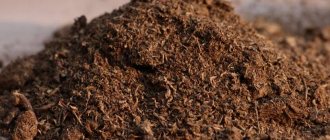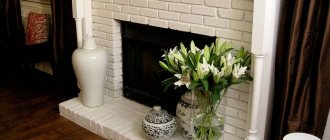The coming winter is an important time for flower growers on our forum. Users of our portal study thick books on floristry and landscape design, draw mixborder schemes, discuss them with their accomplices and redraw them. It's really difficult to create a real mixborder. As a forum member with the nickname Grandma Irisha noted, “all last winter I read, looked at beautiful pictures of landscapers, - so what? You go to your site with that piece of paper with the drawings and a shovel... nothing emerges. All that remains is to plant where your left foot whispers to your right ear.”
What is a mixborder?
In modern landscape design, a mixborder is a flower garden made up of various types of plants, planted in groups, and having an oblong shape.
When creating mixborders, they most often try to use perennial plants, sometimes diluted with annuals. Coniferous and deciduous trees and shrubs, and various vines are also sometimes used.
A rockery is a landscape composition with a predominance of stones. Stones play a dominant role here, plants fade into the background, they only set off and create visible accents. Unlike a rock garden, which is usually built on a hill, a rock garden can be located both on level ground and on terraces.
Watch the video: Mixborders of perennial flowers and conifers
Mixborders can be used as dividers of a park area into sectors; they can decorate the entrance to the garden, decorate a slope, or design a garden path.
There are two types of mixborders: those that are visible from all sides, and those that are created for one-sided decoration.
Kinds
Mixborder schemes vary in style and color. The most popular styles are:
Decorative grass - 140 photos of original design. Review of the best varieties of grass for the garden, instructions, reviews, videos + gardener recommendationsWatering the site - types and types of systems, main differences and features, rules for selection and installation, as well as recommendations for operation
Ornamental plants - 140 photo options. Review of the most popular plants with names and descriptions. Gardener's recommendations + reviews
English. It is a combination of rigor and naturalness. An example would be a mixborder consisting of figuredly trimmed conifers, meadow grasses and varietal garden flowers.
Lugovoy. It is characterized by an abundance of those flowers that can easily be found in nature - daisies, field carnations, forget-me-nots, cornflowers, flax.
Country. This style involves planting lushly flowering vegetation - tulips, roses, spices, fruit bushes.
Garden. This is a unique variation of country style. The difference is in the abundance of vegetable and berry crops.
Collectible. Rare flowers and herbs are collected here.
There are also coniferous mixborders, consisting, as the name suggests, of coniferous plants. Such flower beds retain their decorative properties even in winter.
Boxwood: planting, care, growing in open ground, propagation. Full description of the plant from A to Z. More than 100 photos of evergreen shrubsLiving fence - the best ideas on what to make a hedge from at your summer cottage. Many photos of ready-made options with exclusive designs + instructions
- Trimming bushes - the basics of choosing the right plants and forming the right shapes, selecting tools (photo + video)
It is also worth noting the mixborder made from shrubs. It is quite simple in design. Perennials with an unusual shape or texture of leaves are usually selected for it. If you want to plant a tree, then only as an accent.
If you need to create a romantic atmosphere, give preference to a mixborder with roses. It’s hard to imagine anything more delicate and refined. In addition, the aroma and beauty of roses will not leave anyone indifferent.
Mixborders are also divided according to color into:
- Contrasting. Ideal solution for small plantings. Use flowers in contrasting shades, such as white and blue.
- Monochrome. Plantings of the same color scheme, but in different tones, are planted here.
- Polychrome. It is suggested to plant complementary plants. At the same time, the majority must occupy pastel halftones, and green should go in the background. It is worth remembering that with the onset of darkness, the outermost of the tones “fades” white.
Thus, the design of the entrance area will give aesthetic pleasure to the eyes if you include a flower garden, laid out taking into account the colors of the plantings and their color combinations with each other.
Mixborder styles
Lugovoy. Reflects the romance of mountain and meadow landscapes. Meadow grasses and various cereal crops are used in their creation.
English. There is a strict style in the design here. Clarity of lines, severity of forms and restraint of colors are the main features of such a flower garden.
Rustic. The variety of bright colors, the splendor of flowering, the assortment of plants consists mainly of local crops.
Vegetable. They create a mixborder design from various vegetable crops, choosing the color of leaves and flowers. It also has a functional meaning, because in the fall gardeners can collect their bonus - a harvest of vegetables.
Description
Mixborders in landscape design appeared in the 17th century. The concept itself comes from the French language. “Mix” is translated as “mixing”, and “border” is translated as “border”, “restriction”.
Today, a similar term denotes a flowerbed of any configuration, consisting of all kinds of vegetation, planted in a certain order.
In other words, modern gardeners understand a mixborder as a complex flower garden consisting of annuals, perennials, shrubs and herbs.
Such a landscape element is characterized by the combination of a number of varieties of green spaces, different in shape, size, color, and foliage texture.
The difference from a border or ridge is that planting in such a floral composition is carried out in a free, natural style.
Flowers are arranged in groups, with smooth transitions between them, without sudden changes in color and height.
At the same time, when planting them, it is necessary to focus on a carefully thought-out plan that takes into account many complex nuances.
The peculiarity of the mixborder is as follows: due to the well-chosen composition and correct layout, it retains its decorative properties throughout the season.
A similar flower garden looks equally attractive in both spring and autumn. Plantings are done in tiers, placing tall flowers in the background and low-growing flowers in the foreground.
Color design
It is important for a novice gardener to choose the right color scheme for plants. Having looked at numerous photos of mixborders, you can choose for yourself the most appropriate color design option that will suit your desires and tastes. Here it is important not to overdo it with a variety of shades and to harmoniously place color spots.
For a harmonious combination of color shades, it is advisable to choose no more than 4-5 colors. The chromatic color circle can help a novice designer in choosing shades. Using it, it is easy to determine the contrast of colors and their compatibility.
To create the most harmonious composition, mix warm shades of colors with warm ones, and cool colors with cold ones.
Stages of arrangement with your own hands
The design stages for all mixborders are identical: first, all large plants are planted, after which they begin to plant smaller ones. The composition is completed with ground covers and annuals.
Planting shrubs and trees
The arrangement of the composition begins with planting large plants
Having determined the place to create a mixborder, you can begin planting. Work begins with the largest specimens, around which the rest of the flowerbed will be designed in the future. Such “skeletal” plants will create a general vision of the planned exterior. You should not plant shrubs at equidistant distances. Plants love naturalness and some asymmetry - this should be the main principle when determining the place for each living element. Most shrubs will increase in size several times in a few years, so you should give them room to grow.
Sometimes a flower garden is formed among planted mature trees. In this case, it is necessary to take into account their size and shape. If the trees are very tall, you should not include them in the composition. They can only outline the line of the flower garden being created.
Planting perennials
Perennials are placed at the edge of the flower bed
The next step will be planting perennial plants. It is necessary to place them correctly in the designated area. Tall specimens are placed in the center if the flower garden is visible from all sides, or on the far side if the mixborder is located against the wall. Next, tiers are built that will make the composition effective and harmonious. Among perennial plants there can be not only flowering ones. Beautiful foliage decorates the flower garden no less than colorful inflorescences.
Perennial ground covers are placed at the very edge; they represent the lowest tier of all presented. Not every mixborder assumes the presence of this type of planting.
Planting bulbous and summer flowers
The final stage will be planting bulbous and annual plants. Such flowers look organic in the central part of the composition, but it is important to maintain the tiers - the height of the plantings during the flowering period. They are placed between previously planted perennials.
Mixborder placement
First of all, you need to choose a place for the future flower garden. It must meet the purpose of the mixborder - decorate the edge of the terrace, create a natural fence around the perimeter of the garden, decorate garden paths or be located along the wall of the house. The ideal place for such a flower garden is an area where there is both light and shadow in equal quantities.
- Indoor ventilation
Choosing grass for the lawn
Deutzia is blooming - summer is coming
When choosing a site, it is necessary to take into account the length of the future flower garden, existing restrictions - the height of the windows, the distance from the viewing point, the distance between the path and the mixborder.
The location for the flower garden must have an acceptable level of humidity, sufficient light and shade, as well as sufficient soil fertility.
The design of the mixborder should be created in accordance with the main style of the garden in which you are going to place it.
Color Compatibility
To get an effective mixborder, as in the photo, it is not enough to know only the basic principles of its design (length, width and many tiers). There are many more important points that will help you create the perfect flower garden. Within the mix, you cannot plant plant crops that do not get along together, that is, between which there are antagonistic relationships. Negative neighbors can be, for example:
- Peony and pink.
- Buttercups and bulbous.
- Lilies and tulips.
Almost no plants live with dahlias, so they must be especially carefully included in the composition. If a species has an actively growing “invasive” rhizome that crushes its neighbors, it is correct to exclude it. However, in a situation where you really want to have this particular species in the mix, you need to allocate a separate section of the lawn for it, fencing it with a border.
It is problematic to provide adequate conditions for the growth of each species when their requirements for watering and soil composition are different. It is better for beginning gardeners to choose vegetation with the same moisture requirements, degree of need for sun, and soil pH.
Creating a mixborder
First of all, you need to draw a mixborder diagram, taking into account the characteristic features of such flower beds. There are several rules for creating mixborders.
Plant height. To prevent the top of the flower bed from getting lost during viewing, position the flower bed so that the height of the tallest plant does not exceed half the distance from the viewing point to the flower bed.
A clear mixborder boundary. To achieve clear boundaries, use colored stone chips or tree cuts; you can also use paving slabs or beautiful stones. You can plant a border of low-growing perennial plants.
Planting trees on the siteKerria or Keria: photo and description of the shrub, rules and subtleties of growing a plant with yellow flowers
Ornamental shrubs in landscape design blooming in autumn
Plant plants keeping in mind their mature height. Plant tall ones closer to the center, low ones closer to the edge of the flower bed.
Don't overdo it with too many different types of plants. It is better to use 3-4 decorative species than to create excessive spotting.
When planning a mixborder, avoid overly straight, strict lines. The flower garden looks more elegant, smoothly bending in natural beauty.
Rules for selecting plants
To create a unified composition, you need to choose the right plants
In order to choose the right plants for a mixborder, you should take into account the amount of sunlight falling on the site, the quality of the soil, and whether the flower garden is equipped with an irrigation system. If the place is located under tall trees or on the north side of the house, where there is little access to light, the choice falls on shade-loving plants. In hot, dry places, unpretentious meadow flowers, accustomed to difficult conditions, feel good.
When the owner enjoys gardening and wants to see new colors every year, annuals can be planted. They usually bloom from planting until the first frost. Every year, perennial plantings will delight you more and more with their splendor; great importance is attached not only to the inflorescences, but also to the shape and size of the leaves.
It is rare to find a mixborder in which only annual plants grow. Any composition must have an unshakable foundation, a skeleton - tall flowers, shrubs or even a small tree. Flowers planted as seeds or seedlings in early spring will add bright colors to the flower bed. Such plants include:
- poppy, nigella, petunia, annual geranium, limnanthes, calendula are cold-resistant plantings that feel good in any weather. They will be a great addition to most mixborders, especially those made in meadow or English styles;
- snapdragons, marigolds, cornflowers, iberis, violet, dwarf viola, ageratum - all these flowers delight with their bloom from early summer until late frosts. When planting seeds in a warm place in February and transplanting them into open ground with the onset of the first warm days, flowers will appear in mid-spring;
- carnations, dahlias, asters, annual chrysanthemums, sunflowers - these are annuals;
- ground covers also fit perfectly into mixborders. They are placed in the front part, as they have the smallest height and grow well over the entire surface.
How to care for a mixborder
Rules for caring for a finished mixborder:
- Ensure watering on time.
- Weed weeds in a timely manner.
- Sometimes add fertilizers, both mineral and organic preparations, to watering. This will increase the vitality of plants, add beauty to flowering and resistance to disease.
- Protect heat-loving plants from frost.
- Carry out sanitary, therapeutic and anti-aging pruning in a timely manner.
- Take timely measures to combat diseases and pests.
Guided by these rules for creating and caring for a mixborder, you can not only decorate your garden with a floral miracle, but also surprise your friends with the beauty of the ornamental plants in your flower garden.
Schematic plans
You can create plans and diagrams yourself. The basic rules for planting in a mix come down to the principle of the golden ratio. This means:
- The top is made of plants 1-1.5 in height.
- The middle has specimens up to 1 m.
- The bottom is decorated with soil-covering crops that form the border, and greenery up to 600 mm high.
The golden ratio is calculated according to the scheme: a:b=c:d. Where, a is a form that must be divided into equal parts: b, c, d. The top should be filled with vegetation with large foliage or inflorescences. For example, long-lasting mallow, foxglove or rudbeckia, lupine varieties, and feather grass.
Along the fence
The mixborder in the diagram below, the most successful location of which will be along the fence, consists of:
- Derena cornus alba Gouchaulti,
- Derena Sibirika,
- Diablo bladderwort,
- Tui Smagard,
- Spiraea Vangutta or Chubushnik,
- Thuja occidentalis Hoveyi,
- Euonymus Fortune variety Aurea Variegata,
- Sedum prominent,
- Heucheras,
- Hosts,
- Astilbe,
- Siberian iris,
- Peonov,
- Hortensius.











